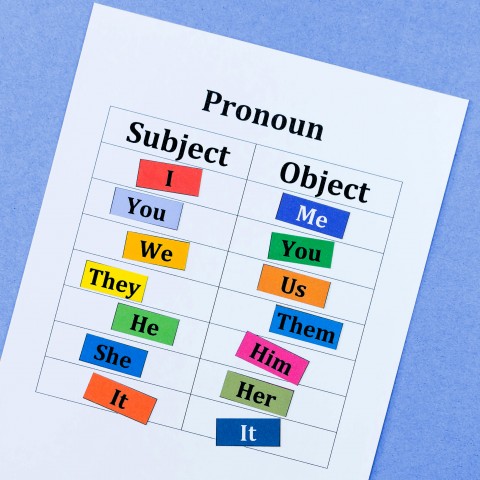
The Polish sentence structure is one of the most important things to study at the beginning of your language-learning journey. Constructing sentences in Polish is easy when you know the rules. So, are you ready to master the Polish word order?
 Table of Contents
Table of Contents
- Polish Word Order: Overview
- Polish Word Order Rules: SVO
- Word Order with Adverbs
- Polish Word Order with Modifiers
- Check Your Understanding: Translation Exercise
- Final Thoughts
1. Polish Word Order: Overview

Let’s start with the basics: the Polish sentence structure for beginners.
The basic word order in Polish is the so-called SVO, which means that the subject comes first, followed by the verb and the object (if there is an object).
The word order in Polish isn’t fixed, but the SVO is a very common sentence structure. Polish allows for considerable creativity, particularly for the sake of emphasis. Having said that, using the SVO structure should come naturally to you as an English speaker, so try to stick to it in the beginning.
2. Polish Word Order Rules: SVO

As we said before, the Polish word order looks like this:
subject + verb + (object) = SV(O)
The subject in a sentence is simply the doer of an activity, which is expressed by the verb. The object is the part of a sentence that’s affected by the verb. Like in English, an object isn’t always required in Polish sentences.
Personal pronouns are dropped in Polish when it’s clear who the “doer” is. This means that a simple sentence in Polish could consist of only a verb. For example:
- Czytam.
“I’m reading.”
Most sentences, for obvious reasons, are more complicated than that:
- Czytam (v) gazetę (o).
“I’m reading a newspaper.”
To emphasize the “doer,” you can also say:
- Ja (s) czytam (v) gazetę (o).
“I’m reading a newspaper.”
The form of the verb czytać (“to read”) indicates that the subject is the first person singular, so it’s not really necessary to use a personal pronoun here.
Also note that Polish doesn’t have the simple or continuous aspects. This means that the same verb form is used to express both. For example:
Czytam (v) gazetę (o). This sentence can be translated as “I’m reading a newspaper,” or “I read a newspaper.”
The meaning is derived from the context.
1- Emphasis and Word Order
From time to time, people change the word order in spoken Polish to stress a different part of the sentence:
- (Ja) gazetę czytam.
“I’m reading a newspaper.”
This sentence stresses the fact that I’m reading a newspaper and not something else. Please remember that it’s not necessary to use a personal pronoun. When it’s there, it’s read as emphasis: It’s I (and not somebody else) who’s reading the newspaper.
2- Different Kinds of Sentences

The Polish sentence structure remains the same for different types of sentences, such as affirmation and negation:
Affirmation
- (Ja) (s) czytam (v) gazetę (o).
“I’m reading a newspaper.”
Negation
- (Ja) (s) nie czytam (v) gazety (o).
“I’m not reading a newspaper.”
Nie, used for negation, always directly precedes the verb.
Exclamatory sentences
- Czytaj (v) gazetę (o)!
“Read a newspaper!”
The subject is missing in this example, as it wouldn’t sound natural.
Questions
- (Ja) (s) czytam (v) gazetę (o)?
“Am I reading a newspaper?”
Polish questions in spoken language are usually indicated by a rising tone. Sometimes in spoken Polish, and as a rule in written Polish, we add czy:
- Czy (ja) (s) czytam (v) gazetę (o)?
“Am I reading a newspaper?”
Czy doesn’t translate well into English as its meaning depends on the context. Have a look at the examples below:
- Czy czytałeś gazetę?
“Were you reading a newspaper?”
- Czy przeczytasz gazetę?
“Will you read a newspaper?”
- Czy on czyta gazetę?
“Does he read a newspaper?”
Remember to simply add czy in front of a sentence to form a question when you’re writing.
Now that we’ve covered the basic word order in Polish for simple sentences, let’s move on to discuss more complex ones.
3. Word Order with Adverbs

In Polish language word order, we usually place adverbs before the verb they modify. Here’s a number of examples for this Polish sentence structure:
- (Ja) (s) szybko (a) czytam (v).
“I read fast.”
Adverbs of manner, such as szybko (“fast”) and wolno (“slowly”), are placed in front of the verb. Would you like to learn some more adverbs? Check out our article, where you can find over 100 of them.
- (Ja) (s) codziennie (a) czytam (v) gazetę (o).
“I read a newspaper every day.”
Adverbs of time and frequency are also placed after the subject, but in front of the verb, if the sentence is a full SVO in Polish. To practice adverbs of frequency, go to our lesson titled “How often do you go to the gym in Poland?“
- (Ja) czytam (v) gazetę (o) w domu.
“I read a newspaper at home.”
(Ja) (s)w domu(a)czytam (v) gazetę (o).
“I read a newspaper at home.”
Adverbs of place are often placed toward the end of the sentence.
1- Change of Placement for Emphasis
The only time we’d change the structure is, yet again, for emphasis:
- (Ja) (s) czytam (v) szybko (a).
“I read fast.”
- (Ja) (s) czytam (v) gazetę (o) codziennie.
“I read a newspaper every day.”
- (Ja) (s) w domu (a) czytam (v) gazetę (o).
“I read a newspaper at home.”
4. Polish Word Order with Modifiers

Modifiers usually modify nouns, and are placed in front of them. Modifiers include adjectives, determiners, numerals, and relative clauses. Relative clauses are an exception as they’re placed after nouns.
1- Placement of Adjectives
Adjectives describe qualities of nouns, like in the example below:
- (Ja) (s) czytam (v) ciekawą (adj) gazetę (o).
“I’m reading an interesting newspaper.”
As you can see above, the adjective breaks up the (S)VO structure, creating (S)VADJO. Have a look at some more examples:
- (Ja) (s) czytam (v) starą (adj) gazetę (o).
“I’m reading an old newspaper.”
- (Ja) (s) czytam (v) lokalną (adj) gazetę (o).
“I’m reading a local newspaper.”
Do you want to learn more adjectives in Polish? Check out this list of high-frequency adjectives.
2- Determiners and Their Placement

A determiner lets you know which noun you’re talking about. Here’s an example of a determiner:
- (Ja) (s) czytam (v) tę (det) gazetę (o).
“I’m reading this newspaper.”
Polish determiners also include:
- (Ja) (s) czytam (v) tamtą (det) gazetę (o).
“I’m reading that newspaper.”
- (Ja) (s) czytam (v) tamte (det) gazety (o).
“I’m reading those newspapers.”
3- Polish Word Order with Numerals
“Numerals” is a fancy word for numbers. Just like other modifiers, they’re placed in front of the noun:
- (Ja) (s) czytam (v) jedną (num) gazetę (o).
“I read one newspaper.”
- (Ja) (s) czytam (v) dwie (num) gazety (o).
“I read two newspapers.”
- (Ja) (s) czytam (v) trzy (num) gazety (o).
“I read three newspapers.”
The pattern remains the same for all numerals. Do you know numbers in Polish well? If not, consult these pages:
4- Polish Word Order Rules for Relative Clauses
A relative clause is an additional way to identify a noun. They’re an exception among modifiers, placed after the noun. Here’s a number of examples for Polish:
- (Ja) (s) czytam (v) gazetę (o), którą lubię.
“I’m reading a newspaper that I like.”
- (Ja) (s) czytam (v) gazetę (o), którą mi poleciłeś.
“I’m reading a newspaper that you’ve recommended to me.”
- (Ja) (s) czytam (v) gazetę (o), której nie znajdziesz w wielu sklepach.
“I’m reading a newspaper that you won’t find in many shops.”
The main difference between the word order in Polish vs. English for relative clauses is that Polish rarely uses non-defining relative clauses. For example:
“My mom, whom I love deeply, lives in England.”

The direct translation is Moja mama, którą bardzo kocham, mieszka w Anglii, which is correct but not natural in Polish. A native speaker would be more likely to use two separate sentences to express the same idea.
Have you noticed that relative clauses are preceded by a comma in Polish? You can learn more about Polish punctuation in the Wikipedia entry on Polish orthography.
5. Check Your Understanding: Translation Exercise
Reading an article is one thing, and making sure that you understand it and can use what you’ve learned is another. This is why we’ve prepared a translation exercise for you. It will help you remember what you’ve read. Remember: practice makes perfect!
Step 1
Translate the sentence “I eat a sandwich,” to Polish. Mark the subject, the verb, and the object. Are all parts of the sentence necessary or can you omit some? If you’re not sure, read the section Polish Word Order Rules: SVO again.
Step 2
Form a question with czy from the sentence “I eat a sandwich.”
Step 3
Add the adverb teraz (“now”) to the sentence “I eat a sandwich.”
Step 4
Add the adjective smaczną (“delicious”) in the correct form to the sentence “I eat a sandwich.” Speaking of delicious food, you should learn about the top 5 Polish dishes.
Step 5
Include the determiner tę (“this”) to the sentence “I eat a sandwich.”
Step 6
Make the sentence “I eat a sandwich,” more specific by including the numeral jedną (“one”).
Step 7
Expand the sentence “I eat a sandwich,” by adding the relative clause którą mi kupiłeś (“that you’ve bought for me”). Don’t forget about the comma.

How did it go? Was it difficult? Let us know in the comments section.
6. Final Thoughts
Today you’ve learned a very important thing, and now you know how to form simple and more complicated sentences in Polish. You can also see the differences between the Polish vs. English sentence structures. Take your time to learn about the word order in Polish grammar, as it’s something you’ll have to build on in order to speak Polish well.
Knowing the basic word order in Polish isn’t enough to become a fluent speaker, though. You’ll need more than that to master the language. Fortunately, PolishPod101 has everything you need! Create your lifetime account today and get access to countless audio and video lessons with native speakers.
Remember to let us know about the results of your translation exercise before you go.
Happy learning!










